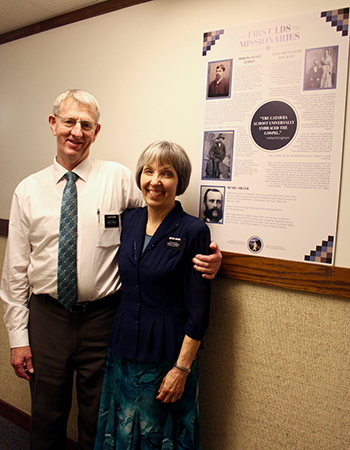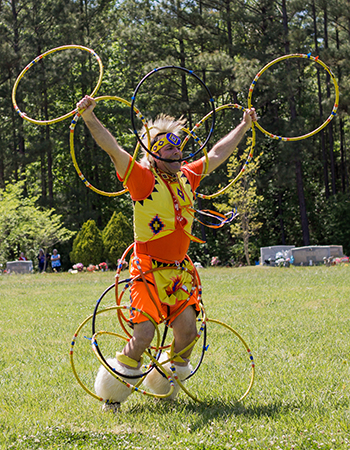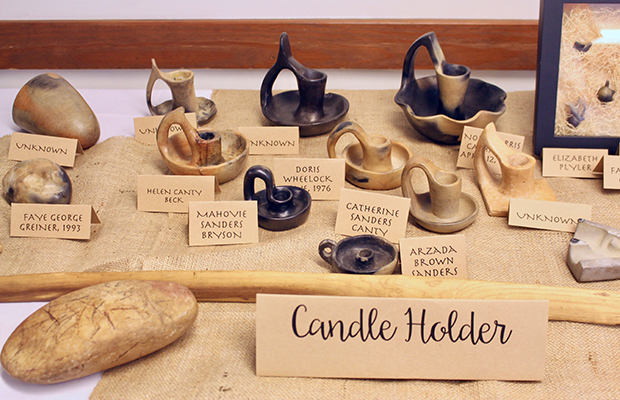South Carolina Ward Celebrates History of the Gospel among the River People
Contributed By Kristen Anderson, Church News contributor

Travis Blue, Ronnie Beck, and Pat Blue performed traditional Indian dancing at the Catawbas and Christ event.
Article Highlights
- The Catawba Branch was formed in 1885.
- A Catawba chief bore testimony in the 1950 April general conference.
- The Catawbas and Christ event took two years to plan.
“We had a hard time starting, but miracles made all of it possible. It will truly be something that will benefit thousands of people now and in the future.” —Matt Burris, organizer of the “Catawbas and Christ” event
Related Links
In April of 2016, the Catawba Ward in South Carolina (which is part of the Charlotte North Carolina South Stake) embarked on a multiyear project to celebrate and commemorate the history of the Catawba Indian tribe and The Church of Jesus Christ of Latter-day Saints.
Catawbas and Christ: A History of the Mormon Church among the River People came to fruition on April 28, 2018. Visitors participated in pottery making, tasted venison stew, and observed Indian dancing, music, and drumming by members of the tribe. The hallways of the Church building were lined with photos and historical accounts written by tribal, family, and ward members with the help of Elder Michael and Sister Karren Boone, from the North Carolina Charlotte Mission. Tribal quilts and artifacts were on display in various classrooms.
Matt Burris and Travis Blue, organizers of the event, offered oral presentations of the Catawbas’ unique history. Mission president Allen Alexander shared the story of the Restoration of the Church. And in the cultural hall, a digital family tree containing 6,500 names was available for Catawba tribal members to search for their ancestors and get printed copies of their family line. This family tree would not have happened without the efforts of Elder Ben and Sister Carol Nilsen, senior missionaries sent to South Carolina specifically for this purpose.
“We had a hard time starting, but miracles made all of it possible,” declared Brother Burris. “It will truly be something that will benefit thousands of people now and in the future.”
Forming the Catawba Branch
The very survival of the Ye Iswa, or the river people, as they are called, is intricately connected with the establishment of the oldest continuous branch of the Church in South Carolina.

Elder and Sister Boone helped the Catawba Ward write historical sketches that were on display at the meetinghouse. Photo courtesy of Kristen Anderson.
In 1878, while traveling to pick up some new missionaries in Virginia, Elder James Henry Moyle, president of the Carolina District of the Southern States Mission, had a vision of a town in South Carolina with a branch of the Church.
“The name was distinct in his mind, but fearing that he might forget it, he arose from bed to write it down. But he could not find a match with which to light the candle and so went back to bed, determined to remember the scene” (Gordon B. Hinckley, James Henry Moyle [1951], 117).
Elder Moyle subsequently requested permission from John Morgan, the Southern States Mission president, to send missionaries to South Carolina. Authorization was eventually granted, but not without warnings of the dangers from the Ku Klux Klan and other violent mobs that were prevalent in the area.
Elders Charles Robison and Henry Miller became the first missionaries to visit the Catawba Indian Reservation in May of 1883. That November, James Patterson, one of the tribal leaders, requested baptism. Four others joined him. On June 1, 1884, the Rock Hill Branch was formed with 31 members, 25 of them Indians, with James Patterson presiding.
Trouble ensued, however, and mobs endangered the lives of both the elders and the families on the reservation. Public meetings ceased, and the branch was disbanded on November 30, 1884. The missionaries were forced into hiding in the woods, subsisting on only what the Catawbas could smuggle in to them. In spite of the threats, secret meetings were held at night and baptisms continued.
Although many preachers from other faiths had unsuccessfully tried to convert the Catawba Indians to Christianity for many years, the Mormons were the only group to find success. The missionaries truly cared about the Catawbas’ physical and spiritual well-being. They organized a school, helped the Catawbas learn valuable skills, and also brought them the history of their forefathers in the Book of Mormon. They were taught “that they were descendants of the lost tribes of Israel [and that] gave them a place—and a respectable place—among the peoples of the world” (Douglas Summers Brown, The Catawba Indians: The People of the River, 341).

Ronnie Beck performs the hoop dance. Photo courtesy of Kaytlin Thomas.
The tribe decided to take a stand and let it be known that the missionaries were welcome on the reservation and that the mobs were trespassers. Armed men stood guard at meetings and bodyguards were provided to protect the elders. On August 2, 1885, with 50 people present, the Catawba Nation Branch was formed. Alonzo Canty was called as branch president. The Catawba Branch was the first branch to be entirely staffed by Indians and is the oldest continuous branch of the Church in South Carolina.
Growth of the Church among the Catawbas
Membership continued to grow, and by 1900, there were 125 members. As the years passed, there were naysayers who tried to convince the Catawbas to abandon Mormonism, but to no avail. In the 1930s, two prominent men in Rock Hill approached Chief Samuel Blue and offered him $1,000 if he would renounce Mormonism. “Esau sold his birthright for a mess of pottage, and Judas betrayed the Savior for 30 pieces of silver, but I would not give up my religion for anything in the world,” he told them. (“Catawba Indians,” Liahona: The Elders Journal [1916], 32:33).
By 1950, 97 percent of the Catawba Indian Nation belonged to The Church of Jesus Christ of Latter-day Saints. In April of that year, through the donations of missionaries and other members, Chief Blue and his wife made a trip to Utah to be sealed in the Salt Lake Temple.
While there, they also attended general conference. During the Sunday morning session, President David O. McKay invited Chief Blue to come to the stand to share an impromptu testimony. “I have been a member of the Church, as you’ve been told, for 60-odd years. … I know this gospel is true. I have tasted the blessing and joy of God. I have seen the dead raised; I have seen the sick whom the doctors have given up, through the administration of the elders, they have been restored to life,” he testified.
“Interest in my ancestors and heritage reaches far back into my life,” said Travis Blue, a great-grandson of Chief Samuel Blue. “I grew up next door to my grandparents, hearing stories of the ancestors and life on the reservation. Names bring faces to my mind that I look forward to meeting one day. I feel I walk the path set forth by Chief Sam Blue … to share Catawba culture with the community to preserve us as a people and enlighten those around us.”

Catawba pottery on display. Photo courtesy of Kristen Anderson.
